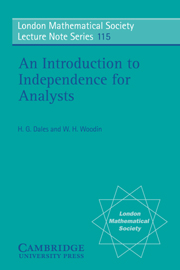Summary
The purpose of this book is to explain what it means for a proposition to be independent of set theory, and to describe how independence results can be proved by the technique of forcing. We do this by presenting an application of forcing to a deep and interesting problem in analysis. Our application is, by current standards in set theory, fairly non-technical, and so it offers an excellent setting in which to exhibit to analysts these new techniques from set theory.
Most analysts will have a certain acquaintance with logic and set theory. They will know naïve set theory up to the level of ordinals and cardinals. They will have heard that forcing is a powerful technique that enables one to prove that certain propositions of set theory are independent of specified axioms, and, in particular, that Cohen developed the method of forcing in his proof that the Continuum Hypothesis (CH) is independent of the basic axioms of set theory, ZFC. They may also know of more recently formulated axioms, such as Martin's Axiom (MA), which can be used to establish independence results without the necessity of knowing any of the technicalities of forcing.
However, it is possible that analysts harbour two negative feelings about these matters. First, they may feel that, although logic and set theory are of interest in their own right, they have little to contribute concerning questions which “really” arise in mathematical analysis, and so can be safely left to their disciples.
- Type
- Chapter
- Information
- An Introduction to Independence for Analysts , pp. vii - xivPublisher: Cambridge University PressPrint publication year: 1987

